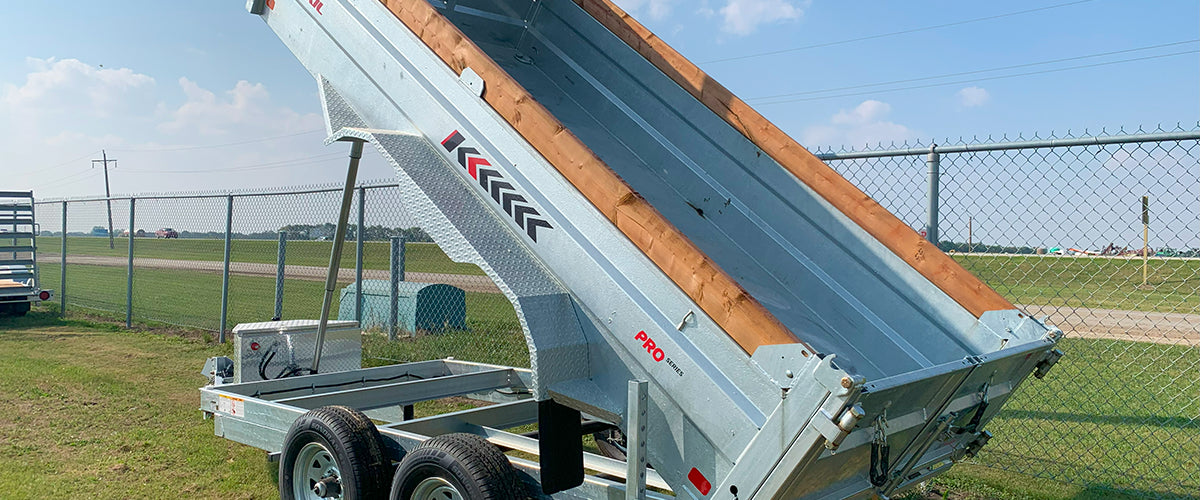Determining the right dump trailer size hinges on its intended purpose. When transporting machinery, it’s essential to ensure that the machinery can comfortably fit within the trailer’s dimensions. However, when considering materials like gravel, dirt, garbage, or construction waste, your focus shifts towards cargo volume rather than just the trailer’s length and width.
Take into account what you plan to carry and the size of your cargo, whether it’s an ATV or a larger skid steer. Additionally, factor in the road conditions you’ll encounter during your journeys. If you anticipate navigating through tight spaces, a more compact trailer might be preferable. On the other hand, if you’re dealing with a high-profile load, ensure your trailer can handle it securely. Making the right choice involves aligning the trailer’s size with the specific demands of your cargo and travel conditions.
When selecting a trailer, consider the weight you need to move, your truck’s towing capacity, and the trailer’s Gross Vehicle Weight Rating (GVWR). GVWR represents the maximum loaded weight the trailer can handle. Make sure your truck can handle at least as much as the trailer’s GVWR. Sometimes, GVWR is based on axle and tire capacity, which can lead to issues with a strong axle but a weak frame.
Check your truck’s owner’s manual to determine its towing capacity, including the trailer’s weight. Consider the maximum cargo load you plan to carry, whether it’s side-by-side, lawn equipment, or construction materials like gravel. Your trailer should match the load capacity, and your towing vehicle must handle both the trailer and the load. Lighter trailers allow for more cargo weight, but always confirm the trailer’s rating for your intended load weight.
MATERIAL
When it comes to trailer materials, you typically have options like aluminum, steel, or galvanized steel. While steel and galvanized steel tend to be more budget-friendly, aluminum stands out as the superior choice. Its lightweight nature and superior resistance to corrosion and rust make it a top pick.
Opting for aluminum is a smart choice, as it offers low maintenance, durability, strength, and a lightweight advantage, making it a reliable and robust option for your trailer needs.
LIFTING MECHANISM
Hydraulic Cylinder Lift Mechanism: This is the most common type of lifting mechanism for dump trailers. It uses hydraulic cylinders to lift the trailer bed.
Hydraulic systems provide strong lifting power and precise control. Consider hydraulic lift mechanisms if you need to handle heavy loads or require precise control over the dumping process.
Scissor Lift Mechanism: Scissor lifts use a system of interconnected bars that extend and retract, lifting the trailer bed. They are known for their stability and ability to lift loads evenly. Scissor lifts are suitable for trailers that need to handle heavy and uneven loads.
Telescopic Cylinder Lift Mechanism: Telescopic cylinders have multiple sections that extend and retract, providing more lifting power and height. They are a good choice for trailers that need to achieve a high dump angle and lift heavy loads.
LIFTING MECHANISM
Electric Screw Drive Mechanism: These mechanisms use an electric motor to turn a screw, which raises and lowers the trailer bed. Electric screw drive mechanisms are often quieter and require less maintenance than hydraulic systems. They are suitable for smaller dump trailers and applications where noise is a concern.
Pneumatic Lift Mechanism: Pneumatic systems use compressed air to lift the trailer bed. They are suitable for trailers that require a clean and oil-free environment, such as in the food industry. Pneumatic mechanisms are typically less powerful than hydraulic systems.
BUILD QUALITY
One critical aspect is the gauge of steel used for the trailer floor. Typically, 7-gauge steel (3/16 inch) is employed for heavy-duty trailers, while lighter-duty smaller trailers that face less wear and tear may use 10 or 11-gauge steel. Beware of manufacturers using 12 or 14-gauge steel for flooring, as this can indicate lower durability, although it reduces costs and overall trailer weight.
The frame is a critical determinant of trailer strength. Many trailers feature tube or channel frames, which provide limited structural integrity when compared to I-beam frames. An I-beam frame consists of a vertical steel piece welded to two horizontal flanges, offering superior support for both vertical and horizontal stress.
- Spreader Gate: If you plan to spread materials like gravel, ensure the trailer has a spreader gate, allowing controlled material release through the bottom.
- AC Charger: To ensure battery charging convenience without relying on a nearby truck, opt for a trailer with an AC/DC converter, enabling charging from an outlet.
- Heavy-Duty Fenders: For frequent access to the trailer’s sides, choose one with robust steps and fenders capable of supporting your weight, as many trailers feature flimsy metal fenders.
- Dual-Acting Hydraulic Unit: If efficiency and speed matter, opt for a dump trailer with a dual-acting hydraulic unit. Unlike single-acting units that rely on gravity to lower the trailer, a dual-acting unit offers smoother operation.
RAMPS
Ramps are valuable accessories for a dump trailer, even if you don’t regularly load heavy equipment. They come in handy for various tasks and make your trailer more versatile.

